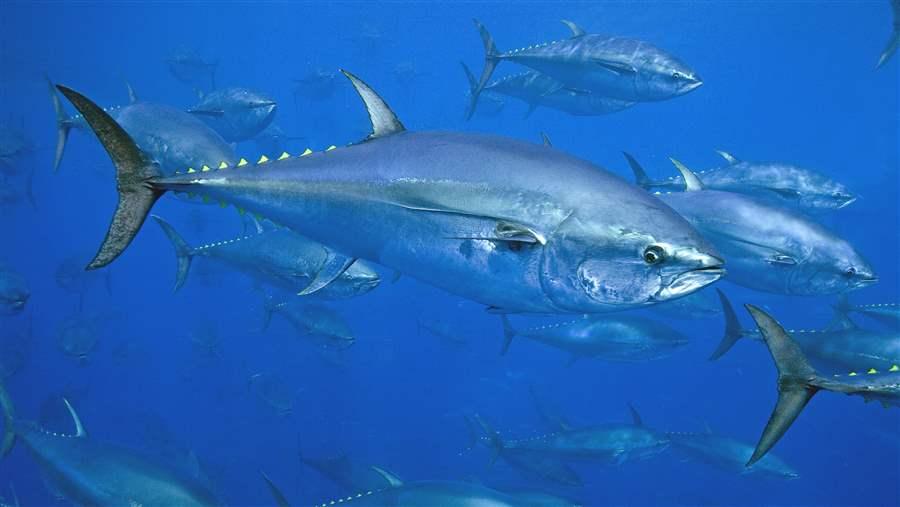Tuna Managers Must Favor Precaution Over Politics to Protect Atlantic Bluefin's Recovery

Atlantic bluefin tuna’s recovery is in jeopardy after risky advice on quotas.
©
The key scientific committee responsible for providing advice to governments managing tuna fishing in the Atlantic Ocean wrapped up a meeting Friday in Madrid in disappointing fashion: by providing risky management recommendations that favor short-term economic gain over long-term sustainability of Atlantic bluefin tuna. Despite strong evidence that precautionary management has supported the recent growth of the species, the Standing Committee on Research and Statistics (SCRS) of the International Commission for the Conservation of Atlantic Tunas (ICCAT) has recommended raising quotas far more abruptly than is justified by the results of the stock assessments and by the precautionary approach that ICCAT committed to in 2015. If the Commission’s managers follow those recommendations, they could jeopardize Atlantic bluefin’s long-term recovery and shatter the positive reputation that ICCAT managers have painstakingly built over the past few years.
The news is the latest indication that ICCAT is walking back a promising pattern. To see the full picture requires revisiting some of the history. In 2009, the science and public outcry surrounding Atlantic bluefin’s status had become too serious for fishery managers to deny or ignore. Both stocks of the species—the eastern, which spawns primarily in the Mediterranean Sea, and the western, which spawns mainly in the Gulf of Mexico—were severely depleted from decades of overfishing, which had continued despite clear advice from scientists that quotas were being set far too high. Facing intense pressure, ICCAT finally agreed to reduce quotas for both stocks in line with scientific advice.
In just five years, the eastern stock began to show clear signs of growth. However, scientists warned of a problematic level of uncertainty in the stock assessments, and advised in 2014 that maintaining the quota at 13,500 metric tons or only “moderately and gradually” increasing it up to 23,256 metric tons would not jeopardize the rebuilding plan. Despite this, ICCAT managers pushed the limit by raising the quota by 72 percent over just three years, and then in 2016, boosted it yet again for the eastern stock, taking it above the scientifically advised limit.
That was not an isolated move: While ICCAT decisions stayed within the bounds of the scientific advice 88 percent of the time between 2009 and 2014, they did so only 43 percent of the time in 2015 and 2016.
This year’s stock assessment showed further growth for Atlantic bluefin, particularly for the eastern stock, but did not confirm that stock’s recovery, as many had hoped it would. Even though scientists cautioned that the signs of growth carried a lot of uncertainty, managers are already facing renewed pressure to dramatically increase the quotas.
ICCAT rules do not permit us to discuss the positions that each country or individual takes at its meetings. But the results of the science meetings that concluded Friday raise the question of whether sufficient guarantees are in place to ensure that ICCAT’s bluefin assessment and management advice are not unduly influenced by politics. Here are the main results:
- The western bluefin stock assessment indicates that this stock is as low as 45 percent of its already depleted 1974 level—and just 18 percent of what it was in 1950—and new data suggest that this is likely an overestimate. The assessment also shows that western bluefin is likely to decline in coming years and that the quota would need to be reduced from 2,000 metric tons to 1,000 metric tons for the stock to grow. That said, the SCRS decided not to provide managers with any indication of stock status, and yet still recommended increasing the quota by 25 percent, to 2,500 metric tons.
- For the eastern stock assessment, scientists ran three scenarios and found that, in one of them, the stock could still be overfished. However, they also admitted to having little confidence in their projections of abundance due to the uncertainty in the assessment, and they expressed concern that key data sets used in the assessment were probably highly overestimating abundance. Similar to the decision in the west, scientists decided to provide no indication of the recovery status of the stock, but nevertheless recommended a increasing the quota to 36,000 metric tons by 2020, even though they predicted that this would cause the stock to decline. If adopted, this would be the highest eastern bluefin quota ever, surpassing what was in place when the stock was in crisis in the 2000s and representing an almost tripling of the quota in six years.
ICCAT managers still have a chance to do the right thing, even in the face of the risky advice that came out of the Madrid meeting. To that end, they should stay committed to precautionary, science-based management. This means adopting quotas that, at a minimum, the science shows will support continued growth—which the SCRS indicated as being 28,000 metric tons or less for eastern bluefin and 1,000 metric tons or less for the western stock. If, on the other hand, the Commission disregards the state of the science and allows toxic influence to reverse recent progress for Atlantic bluefin, the future of the species—and ICCAT’s reputation—will be in jeopardy.
Amanda Nickson directs The Pew Charitable Trusts’ global tuna conservation work.











